Structural Analysis of Self-Weight Loading Standing Trees to Determine Its Critical Buckling Height
Abstract
1. Introduction
2. Methodology
2.1. Target Tree
2.2. Growth Morphometrical Analysis
2.3. Determination of the Stem’s Density and Mechanical Properties
2.4. Determination of Tree Volume
2.4.1. Determination of the Stem Volume
2.4.2. Determination of the Crown Volume
2.5. Determination of the Stem Weight and the Crown Weight
2.6. Stress Analysis of Round Columns due to Self-Weight Loading
2.6.1. Euler Buckling Analysis
2.6.2. Compression Analysis with Ylinen Formula
2.7. Critical Buckling Height (Hcr) Determination
2.7.1. Euler and Ylinen Buckling Stress Methods (Method 1)
2.7.2. Greenhill Buckling Method (Method 2)
2.7.3. Modification of the Greenhill Buckling Method (Method 3)
3. Results and Discussion
3.1. Tree Growth Morphometric and Stem-Crown Characteristics
3.2. Critical Buckling Height
4. Conclusions
Supplementary Materials
Author Contributions
Funding
Institutional Review Board Statement
Informed Consent Statement
Data Availability Statement
Acknowledgments
Conflicts of Interest
References
- Rowe, N.P.; Isnard, S.; Gallenmüller, F.; Speck, T. Diversity of Mechanical Architectures in Climbing Plants: An Ecological Perspective. In Ecology and Biomechanics: A Mechanical Approach to the Ecology of Animals and Plants; Herrel, A., Speck, T., Rowe, N.P., Eds.; CRC Press: Boca Raton, FL, USA, 2006; pp. 35–59. ISBN 978-0-8493-3209-8. [Google Scholar]
- Jaouen, G.; Almeras, T.; Coutand, C.; Fournier, M. How to Determine Sapling Buckling Risk with Only a Few Measurements. Am. J. Bot. 2007, 94, 1583–1593. [Google Scholar] [CrossRef] [PubMed]
- Alméras, T.; Fournier, M. Biomechanical Design and Long-Term Stability of Trees: Morphological and Wood Traits Involved in the Balance between Weight Increase and the Gravitropic Reaction. J. Theor. Biol. 2009, 256, 370–381. [Google Scholar] [CrossRef] [PubMed]
- Shah, D.U.; Reynolds, T.P.; Ramage, M.H. The Strength of Plants: Theory and Experimental Methods to Measure the Mechanical Properties of Stems. J. Exp. Bot. 2017, 68, 4497–4516. [Google Scholar] [CrossRef] [PubMed]
- Spatz, H.-C.; Bruechert, F. Basic Biomechanics of Self-Supporting Plants: Wind Loads and Gravitational Loads on a Norway Spruce Tree. For. Ecol. Manag. 2000, 135, 33–44. [Google Scholar] [CrossRef]
- Brüchert, F.; Becker, G.; Speck, T. The Mechanics of Norway Spruce [Picea Abies (L.) Karst]: Mechanical Properties of Standing Trees from Different Thinning Regimes. For. Ecol. Manag. 2000, 135, 45–62. [Google Scholar] [CrossRef]
- Élie, B.A.-G. GREENHILL—Determination of the Greatest Height Consistent with Stability That a Vertical Pole or Mast Can Be Made, and of the Greatest Height to Which a Tree of given Proportions Can Grow (Hauteur Maxima Compatible Avec La Stabilité d’une Tige Ve. J. Phys. Théor. Appl. 1882, 1, 337–338. [Google Scholar] [CrossRef]
- Kanahama, T.; Sato, M. Mathematical Modelling to Determine the Greatest Height of Trees. Sci. Rep. 2022, 12, 2039. [Google Scholar] [CrossRef]
- Kanno, Y.; Yamada, H. A Note on Truss Topology Optimization under Self-Weight Load: Mixed-Integer Second-Order Cone Programming Approach. Struct. Multidiscip. Optim. 2017, 56, 221–226. [Google Scholar] [CrossRef]
- Huang, X.; Xie, Y.M. Evolutionary Topology Optimization of Continuum Structures Including Design-Dependent Self-Weight Loads. Finite Elem. Anal. Des. 2011, 47, 942–948. [Google Scholar] [CrossRef]
- Félix, L.; Gomes, A.A.; Suleman, A. Topology Optimization of the Internal Structure of an Aircraft Wing Subjected to Self-Weight Load. Eng. Optim. 2019, 52, 1119–1135. [Google Scholar] [CrossRef]
- Ditlevsen, O. Stochastic Model of Self-Weight Load. J. Struct. Eng. 1988, 114, 222–230. [Google Scholar] [CrossRef]
- Jiang, H.; Li, X.; Xin, G.; Yao, Z.; Zhang, J.; Liang, M. Geometry Mapping and Additional Stresses of Ballastless Track Structure Caused by Subgrade Differential Settlement under Self-Weight Loads in High-Speed Railways. Transp. Geotech. 2019, 18, 103–110. [Google Scholar] [CrossRef]
- Jain, N.; Saxena, R. Effect of Self-Weight on Topological Optimization of Static Loading Structures. Alex. Eng. J. 2018, 57, 527–535. [Google Scholar] [CrossRef]
- Wei, D.J.; Yan, S.X.; Zhang, Z.P.; Li, X.-F. Critical Load for Buckling of Non-Prismatic Columns under Self-Weight and Tip Force. Mech. Res. Commun. 2010, 37, 554–558. [Google Scholar] [CrossRef]
- Garcez, G.L.; Pavanello, R.; Picelli, R. Stress-Based Structural Topology Optimization for Design-Dependent Self-Weight Loads Problems Using the BESO Method. Eng. Optim. 2023, 55, 197–213. [Google Scholar] [CrossRef]
- Hur, D.-J.; Kwon, S. Fatigue Analysis of Greenhouse Structure under Wind Load and Self-Weight. Appl. Sci. 2017, 7, 1274. [Google Scholar] [CrossRef]
- Batista dos Santos, R.; Gomes Lopes, C. Topology Optimization of Structures Subject to Self-Weight Loading under Stress Constraints. Eng. Comput. 2022, 39, 380–394. [Google Scholar] [CrossRef]
- Dargahi, M.; Newson, T.; Moore, J. Buckling Behaviour of Trees under Self-Weight Loading. For. Int. J. For. Res. 2019, 92, 393–405. [Google Scholar] [CrossRef]
- Eloy, C.; Fournier, M.; Lacointe, A.; Moulia, B. Wind Loads and Competition for Light Sculpt Trees into Self-Similar Structures. Nat. Commun. 2017, 8, 1014. [Google Scholar] [CrossRef] [PubMed]
- Ancelin, P.; Courbaud, B.; Fourcaud, T. Development of an Individual Tree-Based Mechanical Model to Predict Wind Damage within Forest Stands. For. Ecol. Manag. 2004, 203, 101–121. [Google Scholar] [CrossRef]
- Fourcaud, T.; Blaise, F.; Lac, P.; Castéra, P.; de Reffye, P. Numerical Modelling of Shape Regulation and Growth Stresses in Trees. Trees 2003, 17, 31–39. [Google Scholar] [CrossRef]
- Morgan, J.; Cannell, M.G.R. Shape of Tree Stems—A Re-Examination of the Uniform Stress Hypothesis. Tree Physiol. 1994, 14, 49–62. [Google Scholar] [CrossRef]
- Cannell, M.G.R.; Morgan, J. Branch Breakage under Snow and Ice Loads. Tree Physiol. 1989, 5, 307–317. [Google Scholar] [CrossRef] [PubMed]
- Bahtiar, E.T.; Denih, A.; Putra, G.R. Multi-Culm Bamboo Composites as Sustainable Materials for Green Constructions: Section Properties and Column Behavior. Results Eng. 2023, 17, 100911. [Google Scholar] [CrossRef]
- Niklas, K. Plant Height and the Properties of Some Herbaceous Stems. Ann. Bot. 1995, 75, 133–142. [Google Scholar] [CrossRef]
- Firmanti, A.; Bachtiar, E.T.; Surjokusumo, S.; Komatsu, K.; Kawai, S. Mechanical Stress Grading of Tropical Timbers without Regard to Species. J. Wood Sci. 2005, 51, 339–347. [Google Scholar] [CrossRef]
- Bahtiar, E.T.; Denih, A.; Priadi, T.; Putra, G.R.; Koswara, A.; Nugroho, N.; Hermawan, D. Comparing the Building Code Sawn Lumber’s Wet Service Factors (CM) with Four Commercial Wood Species Laboratory Tests. Forests 2022, 13, 2094. [Google Scholar] [CrossRef]
- Bahtiar, E.T.; Erizal, E.; Hermawan, D.; Nugroho, N.; Hidayatullah, R. Experimental Study of Beam Stability Factor of Sawn Lumber Subjected to Concentrated Bending Loads at Several Points. Forests 2022, 13, 1480. [Google Scholar] [CrossRef]
- Franklin, J.; Mercker, D. Tree Growth Characteristics; University of Tennessee: Knoxville, TN, USA, 2009. [Google Scholar]
- Duryea, M.; Kampf, E.; Littell, R.; Rodríguez-Pedraza, C. Hurricanes and the Urban Forest: II. Effects on Tropical and Subtropical Tree Species. Arboric. Urban For. 2007, 33, 98–112. [Google Scholar] [CrossRef]
- Coder Kim, D. Basic Forms. In Tree Anatomy Series; University of Georgia: Athens, GA, USA, 2014. [Google Scholar]
- Coder Kim, D. Critical Force for Buckling Tree Stems; University of Georgia: Athens, GA, USA, 2000. [Google Scholar]
- Waghorn, M.J.; Watt, M.S. Stand Variation in Pinus Radiata and Its Relationship with Allometric Scaling and Critical Buckling Height. Ann. Bot. 2013, 111, 675–680. [Google Scholar] [CrossRef] [PubMed]
- SNI 7973:2013; Spesifikasi Desain Untuk Konstruksi Kayu (Design Specification for Wooden Construction). Badan Standardisasi Nasional: Jakarta, Indonesia, 2013.
- American National Standard Institution; American Wood Council. NDS, National Design Specification for Wood Construction, ASD/LRFD; American National Standard Institution: Washington, DC, USA; American Wood Council: Washington, DC, USA, 2012. [Google Scholar]
- Nugroho, N.; Bahtiar, E.T. Buckling Formulas for Designing a Column with Gigantochloa Apus. Case Stud. Constr. Mater. 2021, 14, e00516. [Google Scholar] [CrossRef]
- Bahtiar, E.T.; Malkowska, D.; Trujillo, D.; Nugroho, N. Experimental Study on Buckling Resistance of Guadua Angustifolia Bamboo Column. Eng. Struct. 2021, 228, 111548. [Google Scholar] [CrossRef]
- Pretzsch, H.; Biber, P.; Uhl, E.; Dahlhausen, J.; Rötzer, T.; Caldentey, J.; Koike, T.; van Con, T.; Chavanne, A.; Seifert, T.; et al. Crown Size and Growing Space Requirement of Common Tree Species in Urban Centres, Parks, and Forests. Urban For. Urban Green. 2015, 14, 466–479. [Google Scholar] [CrossRef]
- Bitterlich, W. Spiegel-Relaskop: Metric Standard and Metric CP; Relaskop-Technik Vertriebsges m.b.H.: Salzburg, Austria, 1980. [Google Scholar]
- Carson, S.D.; Cown, D.J.; McKinley, R.B.; Moore, J.R. Effects of Site, Silviculture and Seedlot on Wood Density and Estimated Wood Stiffness in Radiata Pine at Mid-Rotation. N. Z. J. For. Sci. 2014, 44, 26. [Google Scholar] [CrossRef]
- Llana, D.F.; Short, I.; Harte, A.M. Use of Non-Destructive Test Methods on Irish Hardwood Standing Trees and Small-Diameter Round Timber for Prediction of Mechanical Properties. Ann. For. Sci. 2020, 77, 62. [Google Scholar] [CrossRef]
- Velsvoski, N.; Andonovski, V.; Vasilevski, K. Research on the Development and Structure of the Crown of Old-Growth Beech Trees on Maleshevski Mountains. In Proceedings of the 5th Congress of The Ecologists of Macedonia, Ohrid, North Macedonia, 19–22 October 2016; The Ecologists of Macedonia: Ohrid, North Macedonia, 2017. [Google Scholar]
- Wang, X.; Ross, R.J.; McClellan, M.; Barbour, R.J.; Erickson, J.R.; Forsman, J.W.; McGinnis, G.D. Nondestructive Evaluation of Standing Trees with a Stress Wave Method. Wood Fiber Sci. 2001, 33, 522–533. [Google Scholar]
- Van Duong, D.; Matsumura, J. Within-Stem Variations in Mechanical Properties of Melia Azedarach Planted in Northern Vietnam. J. Wood Sci. 2018, 64, 329–337. [Google Scholar] [CrossRef]
- Van Duong, D.; Ridley-Ellis, D. Estimating Mechanical Properties of Clear Wood from Ten-year-old Melia Azedarach Trees Using the Stress Wave Method. Eur. J. Wood Wood Prod. 2021, 79, 941–949. [Google Scholar] [CrossRef]
- Van Duong, D.; Schimleck, L.; Tran, D.L.; Vo, H.D. Radial and Among-Clonal Variations of the Stress-Wave Velocity, Wood Density, and Mechanical Properties in 5-Year-Old Acacia Auriculiformis Clones. BioResources 2022, 17, 2084–2096. [Google Scholar] [CrossRef]
- Hu, W.; Li, S.; Liu, Y. Vibrational Characteristics of Four Wood Species Commonly Used in Wood Products. BioResources 2021, 16, 7101–7111. [Google Scholar] [CrossRef]
- Butler, M.A.; Dahlen, J.; Eberhardt, T.L.; Montes, C.; Antony, F.; Daniels, R.F. Acoustic Evaluation of Loblolly Pine Tree- and Lumber-Length Logs Allows for Segregation of Lumber Modulus of Elasticity, Not for Modulus of Rupture. Ann. For. Sci. 2017, 74, 20. [Google Scholar] [CrossRef]
- Tumenjargal, B.; Ishiguri, F.; Takahashi, Y.; Nezu, I.; Baasan, B.; Chultem, G.; Aiso-Sanada, H.; Ohshima, J.; Yokota, S. Predicting the Bending Properties of Larix Sibirica Lumber Using Nondestructive-Testing Methods. Int. Wood Prod. J. 2020, 11, 115–121. [Google Scholar] [CrossRef]
- Wang, X.; Verrill, S.; Lowell, E.; Ross, R.J.; Herian, V.L. Acoustic Sorting Models for Improved Log Segregation. Wood Fiber Sci. 2013, 45, 4. [Google Scholar]
- Van Duong, D.; Schimleck, L. Prediction of Static Bending Properties of Eucalyptus Clones Using Stress Wave Measurements on Standing Trees, Logs and Small Clear Specimens. Forests 2022, 13, 1728. [Google Scholar] [CrossRef]
- Burger, H. Der Kronenaufhau Gleimalteriger Nadelholzbestände. Mitt. Schweiz. Anst. Forstl. Vers. 1939, 21, 5–57. [Google Scholar]
- American Wood Council’s (AWC); ANSI. National Design Specification (NDS) for Wood Construction; American Wood Council: Leesburg, VA, USA, 2018; p. 192. [Google Scholar]
- Senalik, C.A.; Farber, B. Mechanical Properties of Wood. In Wood handbook—Wood as an engineering material; Forest Products Laboratory—USDA, United States Department of Agriculture Forest Service: Washington DC, USA, 2021; pp. 1–46. [Google Scholar]
- Puspitasari, T. Biomekanika Pohon Trembesi (Samanea saman (Jacq.) Merr) Di Lanskap Kampus IPB Dramaga: Analisis Morfometri, Visual, Dan Mekanikal. Undergraduate Thesis, Bogor Agricultural University, Bogor, Indonesia, 2021. [Google Scholar]
- Ishiguri, F.; Makino, K.; Wahyudi, I.; Tanabe, J.; Takashima, Y.; Iizuka, K.; Yokota, S.; Yoshizawa, N. Relationship between Growth and Wood Properties in Agathis Sp. Planted in Indonesia. Wood Res. J. 2017, 3, 1–5. [Google Scholar] [CrossRef]
- Siginer, A. Buckling of Columns of Variable Flexural Rigidity. J. Eng. Mech. 1992, 118, 640–643. [Google Scholar] [CrossRef]
- Li, Z.; Hao, Y.; Kopp, G.A.; Wu, C.-H. Identification of Multimodal Dynamic Characteristics of a Decurrent Tree with Application to a Model-Scale Wind Tunnel Study. Appl. Sci. 2022, 12, 7432. [Google Scholar] [CrossRef]
- Ragula, A.; Chandra, K.K. Tree Species Suitable for Roadside Afforestation and Carbon Sequestration in Bilaspur, India. Carbon Manag. 2020, 11, 369–380. [Google Scholar] [CrossRef]
- Staples, G.W.; Elevitch, C.R. Samanea Saman (Rain Tree); Species Profiles for Pacific Island Agroforestry; Permanent Agriculture Resources (PAR): Holualoa, HI, USA, 2006. [Google Scholar]
- Mattheck, C.; Bethge, K.; Albrecht, W. Failure Modes of Trees and Related Failure Criteria. In Wind and Trees; Cambridge University Press: Cambridge, UK, 1995; pp. 195–203. [Google Scholar]
- Bahtiar, E.T.; Nugroho, N.; Massijaya, M.Y.; Roliandi, H.; Rentry, A.N.; Satriawan, A. A New Method to Estimate Modulus of Elasticity and Modulus of Rupture of Glulam I-Joist. AIP Conf. Proc. 2010, 1325, 319–322. [Google Scholar]
- Nugroho, N.; Kartini; Bahtiar, E.T. Cross-Species Bamboo Grading Based on Flexural Properties. IOP Conf. Ser. Earth Environ. Sci. 2021, 891, 012008. [Google Scholar] [CrossRef]
- Bahtiar, E.T.; Nugroho, N.; Hermawan, D.; Wirawan, W. Khuschandra Triangle Bracing System to Reduce the Vibration Level of Cooling Tower—Case Study in PT Star Energy Geothermal (Wayang Windu) Ltd—Indonesia. Case Stud. Constr. Mater. 2018, 8, 248–257. [Google Scholar] [CrossRef]
- Nurmadina; Nugroho, N.; Bahtiar, E.T. Structural Grading of Gigantochloa Apus Bamboo Based on Its Flexural Properties. Constr. Build. Mater. 2017, 157, 1173–1189. [Google Scholar] [CrossRef]
- de Oliveira, F.G.R.; Sales, A. Relationship between Density and Ultrasonic Velocity in Brazilian Tropical Woods. Bioresour. Technol. 2006, 97, 2443–2446. [Google Scholar] [CrossRef]
- Hasegawa, M.; Takata, M.; Matsumura, J.; Oda, K. Effect of Wood Properties on Within-Tree Variation in Ultrasonic Wave Velocity in Softwood. Ultrasonics 2011, 51, 296–302. [Google Scholar] [CrossRef] [PubMed]
- Van Gelder, H.A.; Poorter, L.; Sterck, F.J. Wood Mechanics, Allometry, and Life-History Variation in a Tropical Rain Forest Tree Community. New Phytol. 2006, 171, 367–378. [Google Scholar] [CrossRef]
- Mosbrugger, V. The Tree Habit in Land Plants; Springer Verlag: Berlin, Germany, 1990. [Google Scholar]
- McMahon, T. Size and Shape in Biology: Elastic Criteria Impose Limits on Biological Proportions, and Consequently on Metabolic Rates. Science 1973, 179, 1201–1204. [Google Scholar] [CrossRef]
- Watt, M.S.; Moore, J.R.; Façon, J.-P.; Downes, G.M.; Clinton, P.W.; Coker, G.; Davis, M.R.; Simcock, R.; Parfitt, R.L.; Dando, J.; et al. Modelling the Influence of Stand Structural, Edaphic and Climatic Influences on Juvenile Pinus Radiata Dynamic Modulus of Elasticity. For. Ecol. Manag. 2006, 229, 136–144. [Google Scholar] [CrossRef]
- Putz, F.E.; Coley, P.D.; Lu, K.; Montalvo, A.; Aiello, A. Uprooting and Snapping of Trees: Structural Determinants and Ecological Consequences. Can. J. For. Res. 1983, 13, 1011–1020. [Google Scholar] [CrossRef]
- Watari, R.; Nagashima, H.; Hirose, T. Stem Extension and Mechanical Stability of Xanthium Canadense Grown in an Open or in a Dense Stand. Ann. Bot. 2014, 114, 179–190. [Google Scholar] [CrossRef]
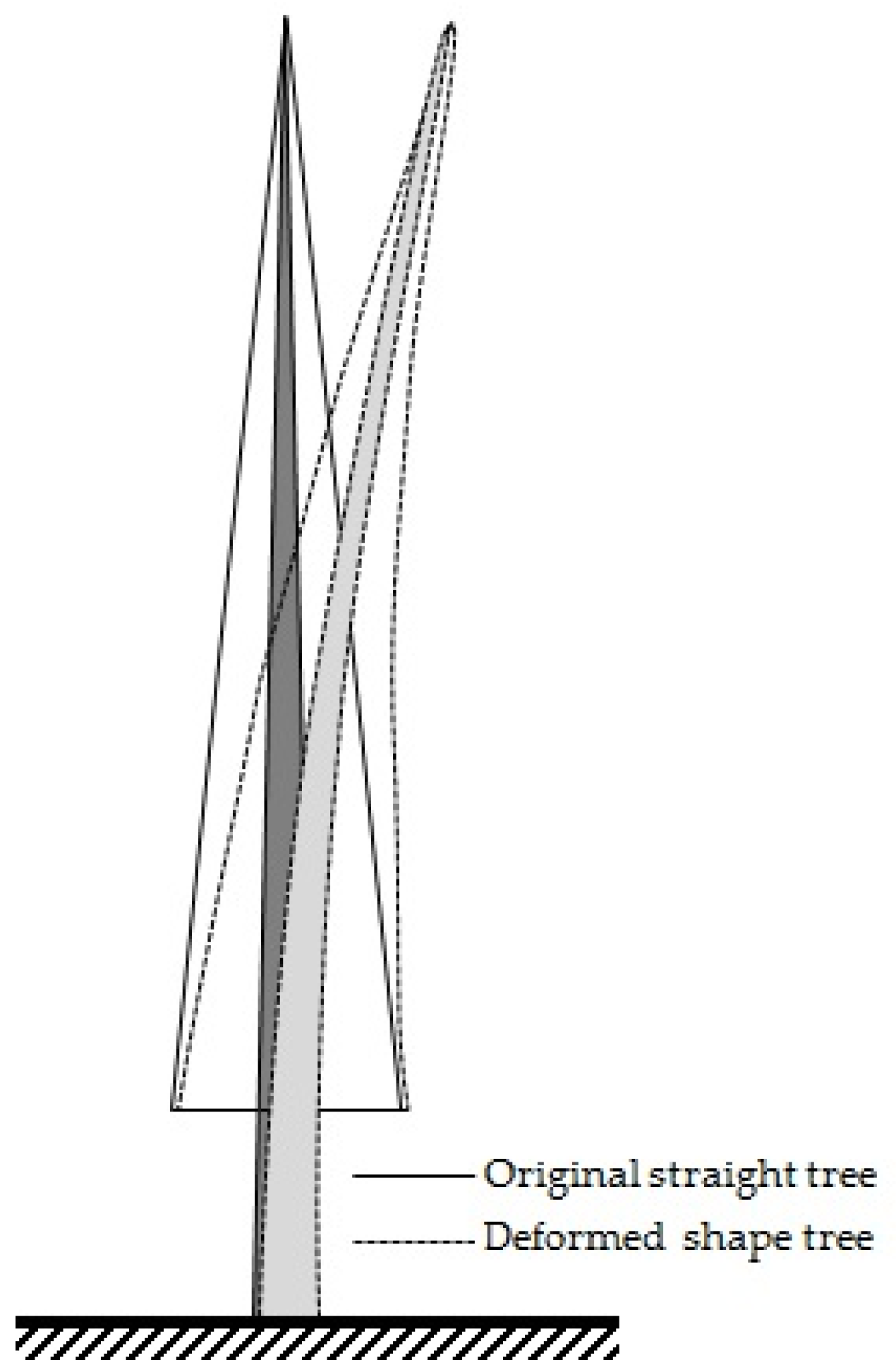
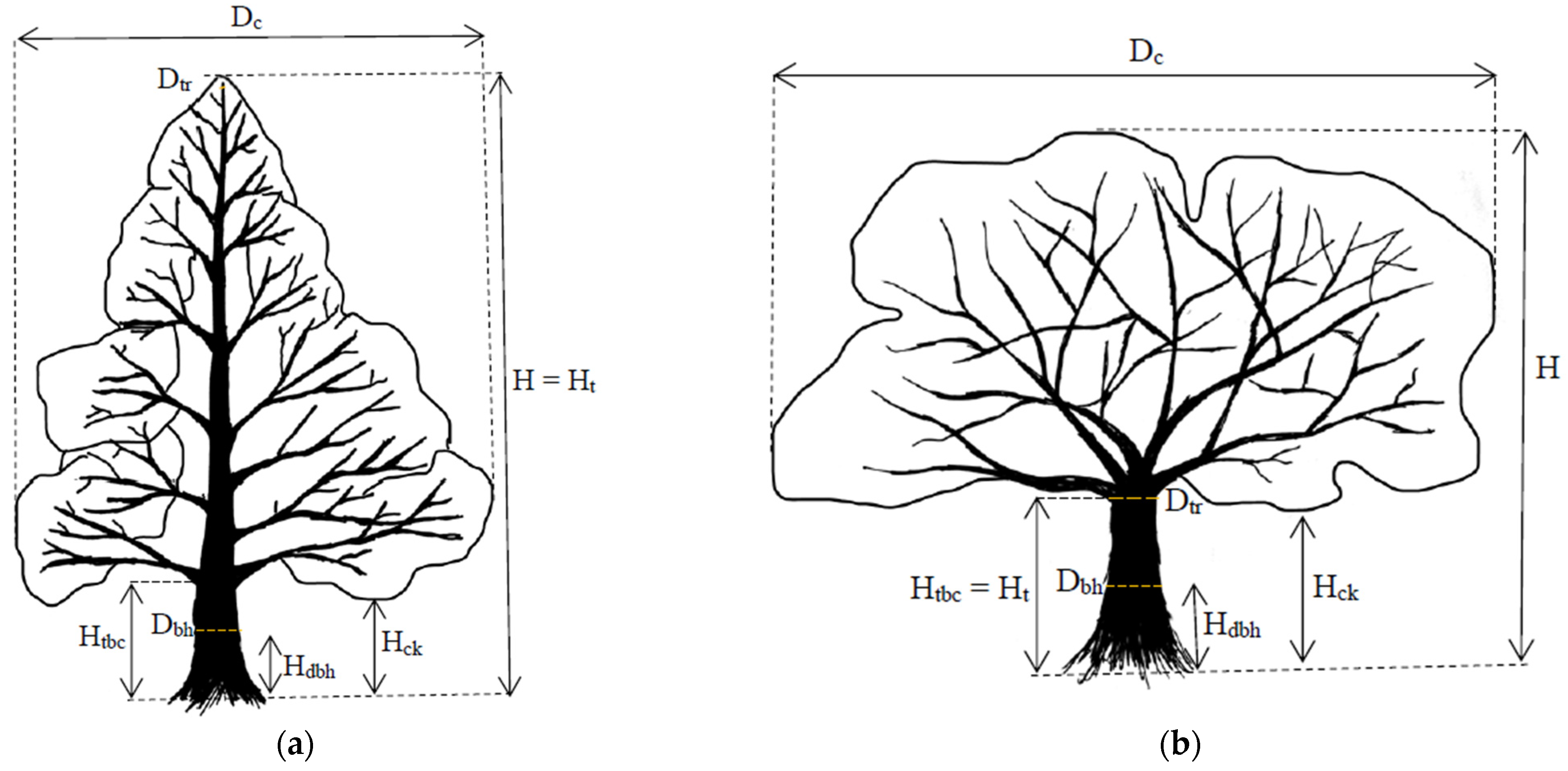
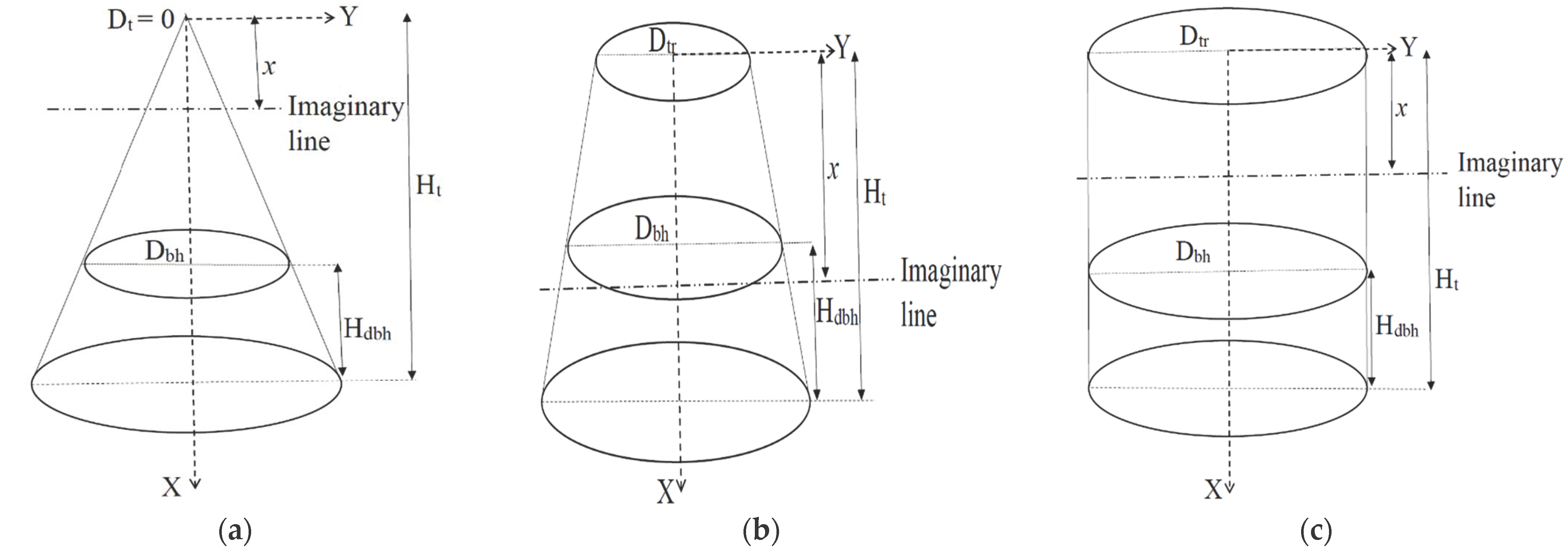
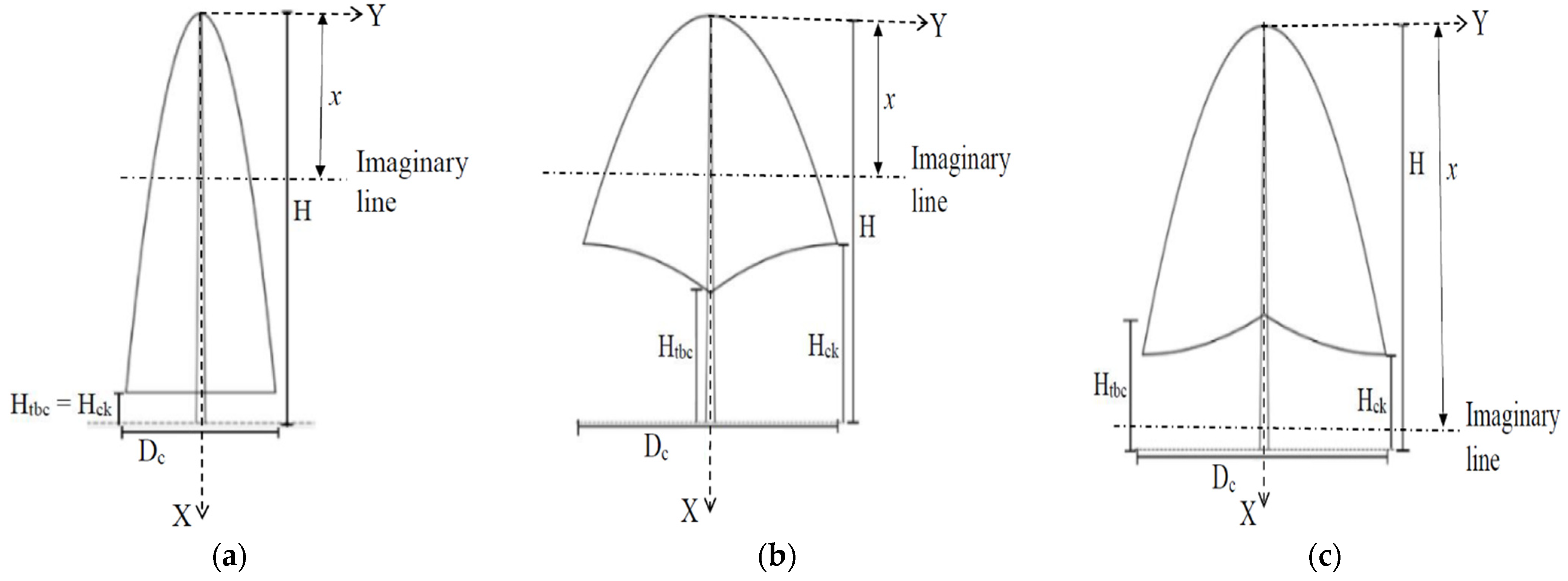


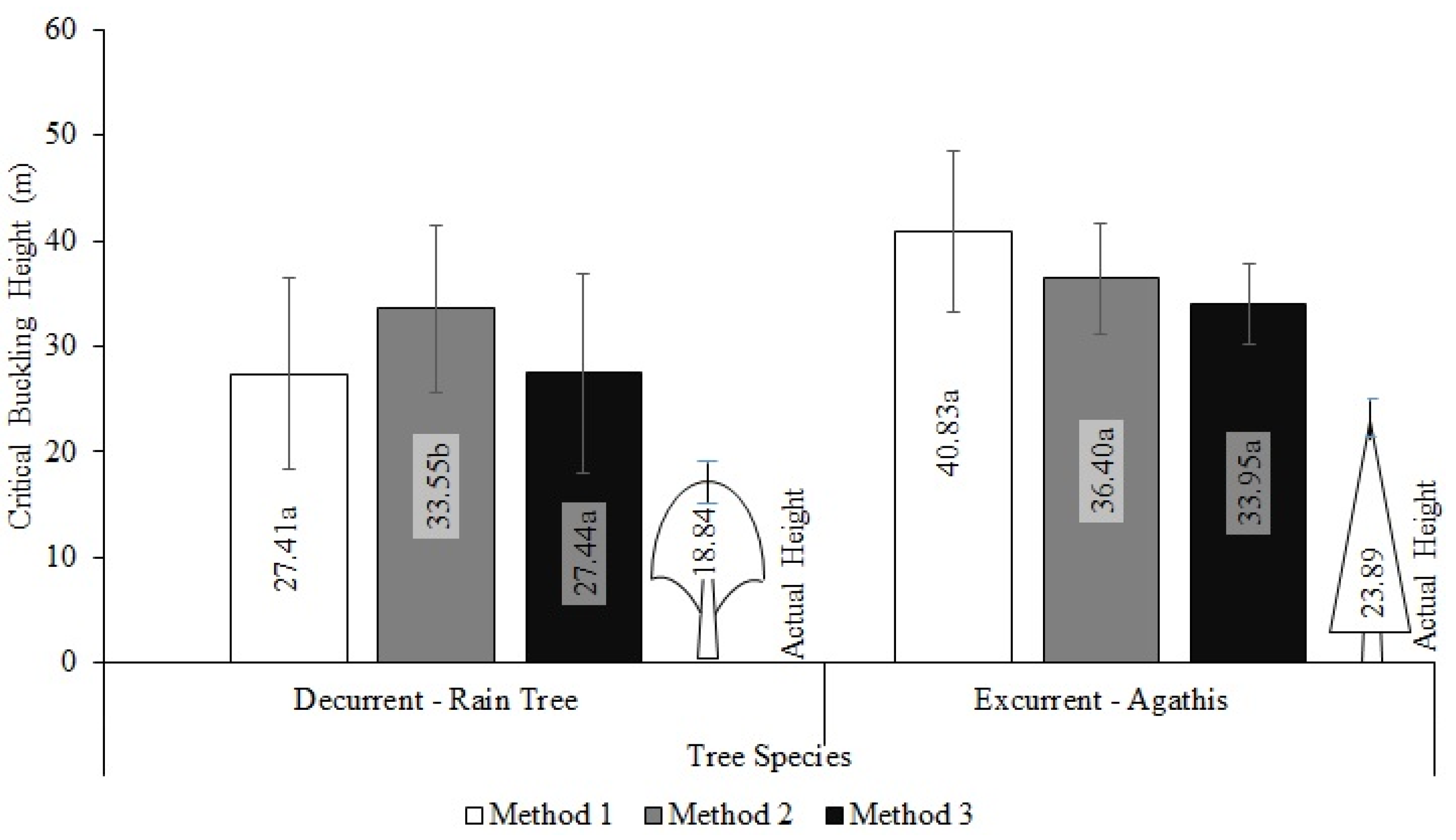
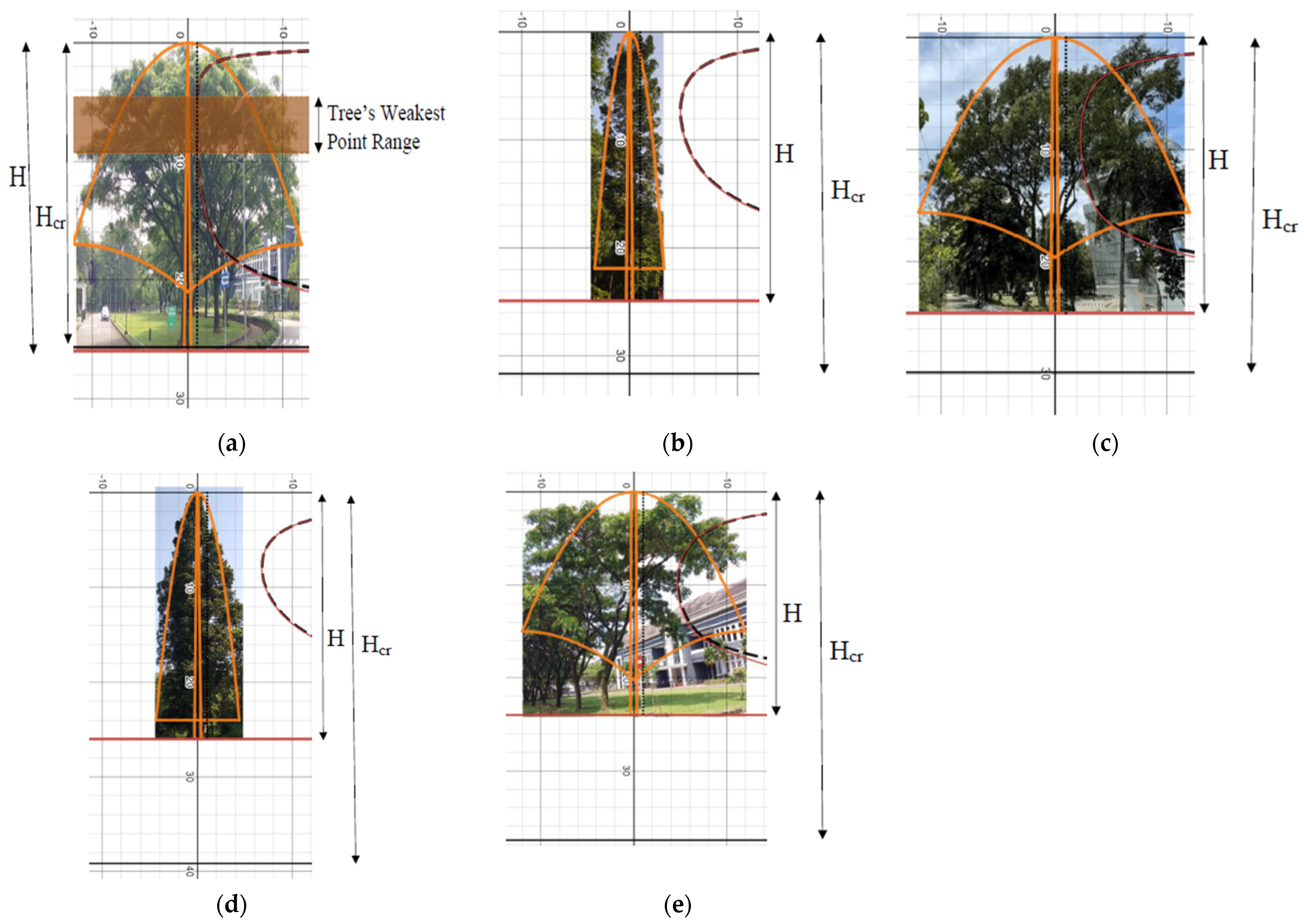
| Parameter | Unit | Agathis (n = 23) | Rain Tree (n = 50) | ||||
|---|---|---|---|---|---|---|---|
| Average | SD | CV | Average | SD | CV | ||
| Total tree height (H) | m | 23.89 | 3.55 | 0.15 | 18.84 | 4.09 | 0.22 |
| Lowest Crown Height (Hck) | m | 2.80 | 0.60 | 0.21 | 6.28 | 1.92 | 0.31 |
| Branch-free Height (Htbc) | m | 2.80 | 0.60 | 0.21 | 2.50 | 1.82 | 0.73 |
| Height when measuring Dtr (Ht) | m | 23.89 | 3.55 | 0.15 | 2.50 | 1.82 | 0.73 |
| Diameter at breast height (Dbh) | cm | 49.96 | 9.96 | 0.20 | 61.48 | 18.54 | 0.30 |
| Diameter at the tip of the tree (Dtr) | cm | 14.02 | 2.58 | 0.18 | 56.85 | 18.93 | 0.33 |
| Corrected diameter at the tip of the tree (Dt) | cm | 14.02 | 2.58 | 0.18 | 55.66 | 18.79 | 0.34 |
| Calculation Diameter at the tip of the tree (Dh) | cm | 14.02 | 2.58 | 0.18 | 22.58 | 29.32 | 1.30 |
| Mean crown diameter (Dc) | m | 6.93 | 0.97 | 0.14 | 19.86 | 4.42 | 0.22 |
| Slenderness (S) | - | 48.94 | 8.67 | 0.18 | 32.07 | 7.74 | 0.24 |
| Wood Density (ρ) | kg/m3 | 722.93 | 73.63 | 0.10 | 778.20 | 64.13 | 0.08 |
| Dynamic Modulus of Elasticity (Ed) | GPa | 8.19 | 3.99 | 0.49 | 4.98 | 1.52 | 0.31 |
| Static Modulus of Elasticity (Es) | GPa | 6.58 | 1.40 | 0.21 | 3.89 | 1.51 | 0.39 |
| Tree Growth Habit | Stem | Crown | ||||||||
|---|---|---|---|---|---|---|---|---|---|---|
| Geometry Model | Volume (m3) (Starting at 10 cm above Ground and Upward) | Weight (N) | Geometry Model | Volume (m3) (Starting at Lowest Height Crown and Upward) | Weight (N) | |||||
| Excurrent | Hooked cone (n = 23) | Av. | 2.38 | Av. | 16,832.58 | Paraboloid (n = 23) | Av. | 2.58 | Av. | 18,280.19 |
| SD | 1.07 | SD | 8021.02 | SD | 0.90 | SD | 6775.03 | |||
| CV | 0.45 | CV | 0.48 | CV | 0.35 | CV | 0.37 | |||
| Decurrent | Hooked cone (n = 35) | Av. | 0.06 | Av. | 455.01 | Paraboloid Duo Type I (n = 34) | Av. | 24.96 | Av. | 187,581.82 |
| SD | 0.13 | SD | 1010.39 | SD | 15.60 | SD | 119,870.71 | |||
| CV | 2.20 | CV | 2.22 | CV | 0.62 | CV | 0.64 | |||
| Paraboloid Duo Type II (n = 1) | Av. | 58.18 | Av. | 467,009.88 | ||||||
| SD | 0 | SD | 0 | |||||||
| CV | 0 | CV | 0 | |||||||
| Cylindrical (n = 15) | Av. | 0.57 | Av. | 4490.90 | Paraboloid Duo Type I (n = 15) | Av. | 20.41 | Av. | 158,753.47 | |
| SD | 0.42 | SD | 3404.90 | SD | 13.46 | SD | 104,419.83 | |||
| CV | 0.74 | CV | 0.76 | CV | 0.66 | CV | 0.66 | |||
| Tree Condition | Safety Factor (Sf) | Tree Species | |||
|---|---|---|---|---|---|
| Rain Tree | Agathis | ||||
| Number of Trees | Percentage (%) | Number of Trees | Percentage (%) | ||
| Unsafe | Sf ≤ 1.00 | 5 | 10 | 0 | 0 |
| Safe | 1.00 < Sf ≤ 1.645 | 31 | 62 | 10 | 43 |
| Very Safe | Sf > 1.645 | 14 | 28 | 13 | 57 |
Disclaimer/Publisher’s Note: The statements, opinions and data contained in all publications are solely those of the individual author(s) and contributor(s) and not of MDPI and/or the editor(s). MDPI and/or the editor(s) disclaim responsibility for any injury to people or property resulting from any ideas, methods, instructions or products referred to in the content. |
© 2023 by the authors. Licensee MDPI, Basel, Switzerland. This article is an open access article distributed under the terms and conditions of the Creative Commons Attribution (CC BY) license (https://creativecommons.org/licenses/by/4.0/).
Share and Cite
Karlinasari, L.; Bahtiar, E.T.; Kadir, A.S.A.; Adzkia, U.; Nugroho, N.; Siregar, I.Z. Structural Analysis of Self-Weight Loading Standing Trees to Determine Its Critical Buckling Height. Sustainability 2023, 15, 6075. https://doi.org/10.3390/su15076075
Karlinasari L, Bahtiar ET, Kadir ASA, Adzkia U, Nugroho N, Siregar IZ. Structural Analysis of Self-Weight Loading Standing Trees to Determine Its Critical Buckling Height. Sustainability. 2023; 15(7):6075. https://doi.org/10.3390/su15076075
Chicago/Turabian StyleKarlinasari, Lina, Effendi Tri Bahtiar, Adhelya Suci Apriyanti Kadir, Ulfa Adzkia, Naresworo Nugroho, and Iskandar Z. Siregar. 2023. "Structural Analysis of Self-Weight Loading Standing Trees to Determine Its Critical Buckling Height" Sustainability 15, no. 7: 6075. https://doi.org/10.3390/su15076075
APA StyleKarlinasari, L., Bahtiar, E. T., Kadir, A. S. A., Adzkia, U., Nugroho, N., & Siregar, I. Z. (2023). Structural Analysis of Self-Weight Loading Standing Trees to Determine Its Critical Buckling Height. Sustainability, 15(7), 6075. https://doi.org/10.3390/su15076075














